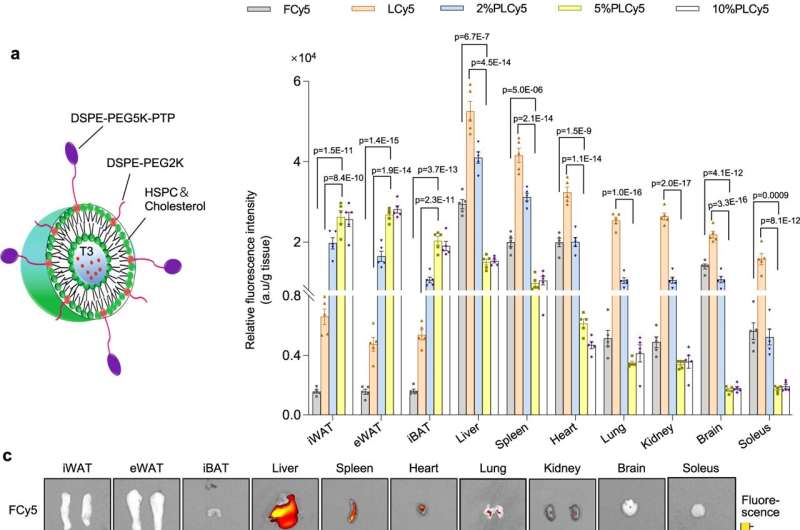This article has been reviewed according to Science X's editorial process and policies. Editors have highlighted the following attributes while ensuring the content's credibility:
fact-checked
peer-reviewed publication
trusted source
proofread
Nanoparticle-based targeted drug delivery system for treatment of obesity and atherosclerosis

A research team from LKS Faculty of Medicine, the University of Hong Kong (HKUMed) has developed thyroid hormone (TH)–encapsulated nanoparticles modified with an adipose-homing peptide, which selectively transports TH to adipose tissues. This will advance the treatment of obesity-related medical complications with TH by overcoming the severe adverse effects caused by systemic administration. The new findings are now published in Nature Communications.
Obesity is a major risk factor for multiple life-threatening chronic diseases such as diabetes and cardiovascular and neurodegenerative disorders. TH is an ancient hormone with therapeutic potential for obesity and its related medical complications by promoting energy expenditure. However, despite enormous research efforts in the past decades, clinical trials have failed to demonstrate obvious clinical benefits of chronic systemic administration of TH on weight loss in obese individuals.
Furthermore, due to widespread expression of TH receptors, systemic administration of TH often leads to serious deleterious effects on multiple organs, including tachycardia, heart attack, muscle wasting, and osteoporosis. Skeletal muscle and adipose tissues are thought to be the two major target organs where TH exerts its stimulatory actions on metabolic rate and energy expenditure. However, whether selective delivery of TH to adipose tissues is sufficient to induce weight loss remains unclear.
The research team developed TH-encapsulated nanoparticles, modified with an adipose-homing peptide to selectively deliver TH to adipose tissues. Remarkably, the researchers found that adipose-targeted delivery of TH is substantially more potent than systemic TH therapy in reducing obesity and its related metabolic complications, with no adverse effect on other non-adipose tissues.
Mechanistically, the study uncovered that adipose-targeted TH therapy can convert "bad" white fat to "good" brown fat, which can burn calories by creating heat, whereas systemic TH therapy is unable to induce "browning" of white fat due to its suppression of sympathetic nerves. Furthermore, the research team made an unexpected finding that adipose-targeted delivery of TH effectively alleviates hypercholesterolemia and atherosclerosis, major causes of coronary heart disease and ischemic stroke.
"This is the first proof-of-concept study showing that nanoparticle-based targeted delivery of TH to adipose tissue is an effective and safe pharmacotherapy for obesity and its related cardiometabolic complications. The findings have also resolved a long-standing mystery of why systemic TH therapy failed to reduce body weight, thus reigniting the hope of using this ancient hormone for treatment of common chronic diseases through nanoparticle-based precision target delivery," said Professor Xu Aimin, Director of State Key Laboratory of Pharmaceutical Biotechnology and Professor of Department of Medicine, School of Clinical Medicine, HKUMed.
More information: Kang Chen et al, Adipose-targeted triiodothyronine therapy counteracts obesity-related metabolic complications and atherosclerosis with negligible side effects, Nature Communications (2022). DOI: 10.1038/s41467-022-35470-4
Journal information: Nature Communications
Provided by The University of Hong Kong




















